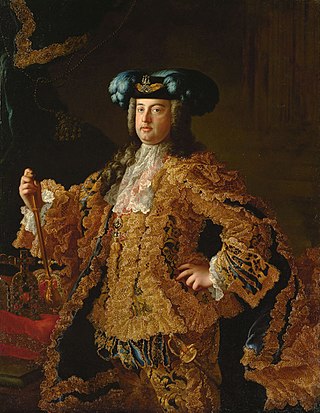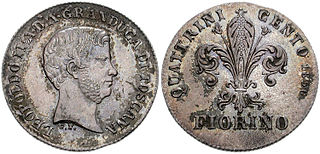Related Research Articles

The House of Medici was an Italian banking family and political dynasty that first consolidated power in the Republic of Florence under Cosimo de' Medici, during the first half of the 15th century. The family originated in the Mugello region of Tuscany, and prospered gradually until it was able to fund the Medici Bank. This bank was the largest in Europe during the 15th century and facilitated the Medicis' rise to political power in Florence, although they officially remained citizens rather than monarchs until the 16th century.
Grand duke is a European hereditary title, used either by certain monarchs or by members of certain monarchs' families. In status, a grand duke traditionally ranks in order of precedence below an emperor, equal to a King, Grand prince, Archduke, or Prince-Archbishop, and above a sovereign prince or sovereign duke. The title is used in some current and former independent monarchies in Europe, particularly:

Francis I was Holy Roman Emperor, Archduke of Austria, Duke of Lorraine and Bar, and Grand Duke of Tuscany. He became the ruler of the Holy Roman Empire, Austria, and Tuscany through his marriage to Maria Theresa, daughter of Emperor Charles VI. Francis was the last non-Habsburg monarch of the Empire. The couple were the founders of the Habsburg-Lorraine dynasty, and their marriage produced sixteen children.

The Grand Duchy of Tuscany was an Italian monarchy that existed, with interruptions, from 1569 to 1860, replacing the Republic of Florence. The grand duchy's capital was Florence. In the 19th century the population of the Grand Duchy was about 1,815,000 inhabitants.

Ferdinando I de' Medici, Grand Duke of Tuscany was Grand Duke of Tuscany from 1587 to 1609, having succeeded his older brother Francesco I.

The Duchy of Lucca was a small Italian state existing from 1815 to 1847. It was centered on the city of Lucca.

Ferdinand IV, Grand Duke of Tuscany was the last Grand Duke of Tuscany from 1859 to 1860.

The scudo was the name for a number of coins used in various states in the Italian peninsula until the 19th century. The name, like that of the French écu and the Spanish and Portuguese escudo, was derived from the Latin scutum ("shield"). From the 16th century, the name was used in Italy for large silver coins. Sizes varied depending on the issuing country.

The Tuscan fiorino was the currency of Tuscany between 1826 and 1859. It was subdivided into 100 quattrini, a local currency made by four denari. There was an additional denomination called the paolo, worth 40 quattrini, in circulation.

The lira was the currency of the Grand Duchy of Tuscany until its annexation by Napoleonic France in 1807. After that year, it unofficially remained in circulation thanks to its silver value until the restoration of Tuscan independence in 1814. It was finally abolished in 1826.
The lira was the currency of the Republic of Lucca until 1800 and again of the Duchy of Lucca between 1826 and 1847. It was subdivided into 20 soldi, each of 3 quattrini or 12 denari.
The Papal Mint is the pope's institute for the production of hard cash. Papal Mint also refers to the buildings in Avignon, Rome, and elsewhere that used to house the mint.
Between 1851 and 1860, the Grand Duchy of Tuscany, an independent Italian state until 1859 when it joined the United Provinces of Central Italy, produced two postage stamp issues which are among the most prized classic stamp issues of the world, and include the most valuable Italian stamp.

The Principality of Lucca and Piombino was created in July 1805 by Napoleon I for his beloved sister Elisa Bonaparte. It was a state located on the central Italian Peninsula and was a client state of Napoleonic France.

Italy has a long history of different coinage types, which spans thousands of years. Italy has been influential at a coinage point of view: the medieval Florentine florin, one of the most used coinage types in European history and one of the most important coins in Western history, was struck in Florence in the 13th century, while the Venetian sequin, minted from 1284 to 1797, was the most prestigious gold coin in circulation in the commercial centers of the Mediterranean Sea.
The baiocco is an ancient Italian currency denomination largely used in Central Italy, especially in Latium.

The Paolo or Paulo was a pontifical coin; this name was given to the giulio by 2 grossi when in 1540 Pope Paul III made it increase its silver content to 3.85 g.

The flag of Tuscany is the official flag of the region of Tuscany, Italy. The flag depicts a silver Pegasus rampant on a white field between two horizontal red bands. The flag first appeared as a gonfalon on 20 May 1975 along with accompanying text Regione Toscana above the Pegasus. It was officially adopted as the flag of Tuscany on 3 February 1995.

The Mirandola mint, also known as the mint of the Pico della Mirandola, was the mint of the Duchy of Mirandola.